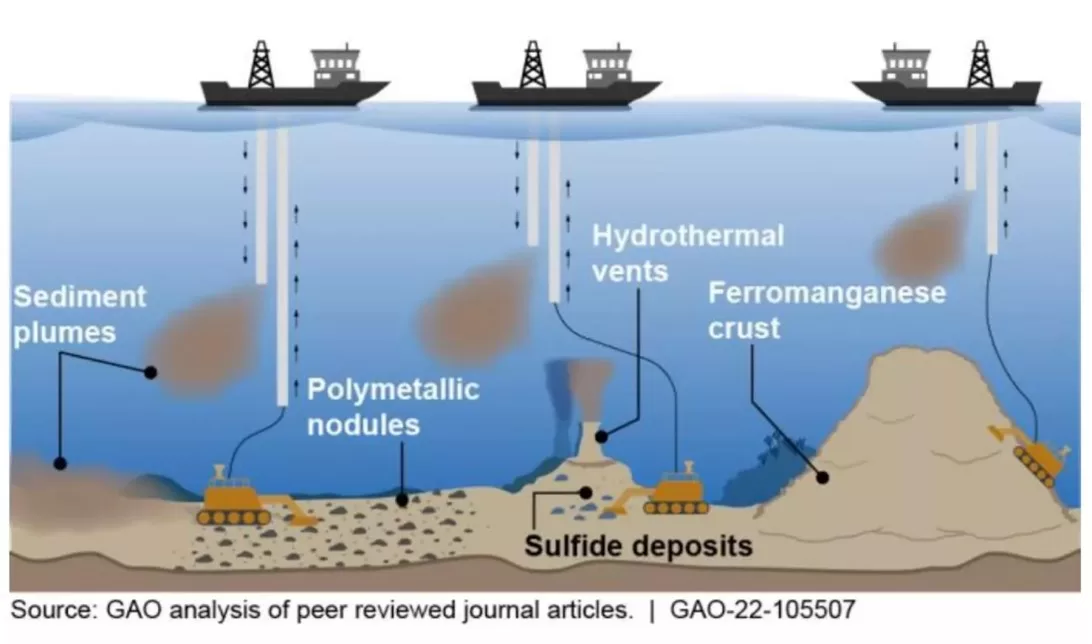Economics, Environment & Ecology
Context: Recently, a study published in the journal Frontiers in Marine Science has warned that commercial deep-sea mining could pose a serious risk to ocean ecosystems.
About Deep-Sea Mining:
- It refers to the extraction of minerals and other resources from the seabed, which can be found in large quantities in the deep ocean.
- These minerals include metals such as copper, nickel, cobalt, and rare earth elements, as well as valuable resources such as oil and gas.
- Despite the risks to ocean ecosystems, the Pacific Island nation of Nauru plans to start deep-sea mining, invoking a two-year rule inserted as a part of the UN Convention on Law of the Seas (UNCLOS).
- The “two-year rule” clause of the UNCLOS requires the ISA to put in place the governance infrastructure – the rules, regulations, and procedures governing the contours of deep-sea mining within two years of approval.
- India has been allotted a site of 75,000 square kilometers in the Central Indian Ocean Basin (CIOB) by the UN International Sea Bed Authority for exploitation of polymetallic nodules.
- A fraction of that reserve can meet the energy requirement of India for the next 100 years,
- India’s Exclusive Economic Zone spreads over 2.2 million square kilometres.
- A manned submersible will be developed to carry three people to a depth of 6,000 meters in the ocean with a suite of scientific sensors and tools.
Major types of deep-sea mining:
- Manganese nodule mining: This involves collecting nodules of manganese, iron, and other metals that are scattered on the ocean floor.
- Seafloor massive sulphide (SMS) mining: This involves extracting mineral deposits formed near hydrothermal vents, which can contain high concentrations of copper, zinc, and other metals.
- Cobalt crust mining: This involves collecting crusts of cobalt, nickel, and other metals that form on the surface of seamounts.
Significance of Deep-Sea mining:
- Growing demand for minerals: It has the potential to provide a reliable and abundant supply of minerals the demand for which is rapidly increasing, driven by the growth of industries such as renewable energy, electric vehicles, and consumer electronics.
- Depletion of land-based resources: Deep-sea mining presents an opportunity to access new sources of valuable resources such as cobalt and rare earth metals which are essential to modern technology and industry but are becoming increasingly scarce on land.
- Strategic importance: Developing a domestic supply of these resources is seen as strategically important for India as many of the minerals and metals that are found in deep sea mining, such as cobalt and rare earth metals, are essential to national security and defence.
- Economic benefits: It has the potential to create jobs, stimulate economic growth, and generate revenue for governments and companies.
Major Issues associated with the deep-sea mining:
- Environmental impacts: Mining operations can disturb and damage fragile deep-sea ecosystems, including coral reefs, hydrothermal vents, and other important habitats.
- Thermal pollution: The mining vehicles also generate sediment plumes that could smother the benthic species at the bottom of the ocean.
- Noise pollution: The process generates noise pollution that can overlap with the frequencies at which cetaceans communicate, causing auditory masking and behavioral changes in marine mammals.
- Regulatory gaps: There is currently a lack of international regulations governing deep-sea mining, which could lead to environmental harm and other negative impacts.
- Social and economic impacts: The potential benefits of deep-sea mining may not be evenly distributed, and could lead to social and economic disparities between different communities.
- Technological challenges: Deep-sea mining requires advanced technologies and equipment that are currently under development, and may not be cost-effective or efficient enough to make the practice commercially viable.
Govt of Initiatives to promote deep sea mining:
- National Centre for Polar and Ocean Research (NCPOR): It was established in 2020 by the Ministry of Earth Sciences in Goa, which is tasked with exploring the country’s deep-sea mineral wealth.
- Draft Deep Seabed Mining Regulations, 2021: It has been formulated by the Indian government to provide a legal framework for the exploration and exploitation of mineral resources in the country’s exclusive economic zone (EEZ).
- International collaborations: The government is also considering setting up a nodal agency to regulate deep sea mining activities in the country, in line with the International Seabed Authority (ISA) and the United Nations Convention on the Law of the Sea (UNCLOS).
Way Forward:
- Studies for understanding deep sea: To understand what species live in the deep sea, how they live, and how they could be affected by mining activities baseline studies are needed with more funds for training and educational programmes focused on improving our understanding of the deep sea.
- Environmental impact assessments: These assessments are also needed to ensure that the loss of biodiversity as a result of mining operations is properly accounted for in mining regulations set by authorities, well before any decision to mine is approved.
- The costs to the marine environment should be included in the financial and economic assessments conducted by mining companies.
- Enhanced regulation: The ISA is operating with the dual mandate of promoting the development of deep-sea minerals whilst ensuring that this development is not harmful to the environment.
- This challenging and conflicting mandate will require improved oversight by the international community – including government representatives and the general public – to ensure that marine life is adequately protected.
- To avoid possible conflicts of interest due to the dual mandate of ISA, the organization should consider divesting itself of some of its responsibilities, and placing them on independent entities.
- Mitigation: Current technologies may not be sufficient to avoid serious and lasting harm to the environment, including the loss of biodiversity.
- Mining operations strategies should be based on the avoidance of environmental impacts.
- This requires stringent and precautionary controls on the permissible extent and duration of mining operations to keep large parts of the seabed undisturbed.
- Minimising impacts should involve, among other things, improving mining equipment to reduce seafloor disturbance.
- Circular economy: The repair, recycling and reuse of products should be encouraged to help reduce the demand for raw materials from the deep sea.
- Enhancing product design to make use of less or alternative materials can also reduce the demand.
Source: Down To Earth










